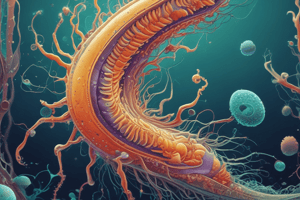Podcast
Questions and Answers
Which characteristic is NOT unique to protozoa?
Which characteristic is NOT unique to protozoa?
- They are single-celled organisms
- They are heterotrophic
- They belong to the kingdom Protista
- They have a cell wall (correct)
What is the primary function of flagella in protozoa?
What is the primary function of flagella in protozoa?
- Regulating osmotic pressure
- Movement (correct)
- Sensing the environment
- Generating energy through respiration
Which type of protozoa is characterized by the formation of spores?
Which type of protozoa is characterized by the formation of spores?
- Amoebas
- Sporozoa (correct)
- Ciliates
- Flagellates
What is the function of the endoplasm in protozoa?
What is the function of the endoplasm in protozoa?
Which type of nutrition involves the absorption of nutrients from dead organic matter?
Which type of nutrition involves the absorption of nutrients from dead organic matter?
What is the primary difference between aerobic and anaerobic respiration?
What is the primary difference between aerobic and anaerobic respiration?
Which type of reproduction involves the formation and fusion of gametes?
Which type of reproduction involves the formation and fusion of gametes?
What is the function of the mitochondria in protozoa?
What is the function of the mitochondria in protozoa?
Flashcards are hidden until you start studying
Study Notes
Definition and Characteristics
- Protozoa are a group of eukaryotic microorganisms that belong to the kingdom Protista.
- They are single-celled organisms, usually microscopic, and can be found in almost every environment.
- Protozoa are heterotrophic, meaning they obtain their energy by consuming other organisms or organic matter.
Types of Protozoa
- Amoebas (e.g., Amoeba proteus): characterized by their ability to change shape and move using pseudopodia.
- Flagellates (e.g., Giardia lamblia): possess flagella, which are whip-like structures used for movement.
- Ciliates (e.g., Paramecium caudatum): have cilia, which are short hair-like structures used for movement and sensing.
- Sporozoa (e.g., Plasmodium falciparum): parasitic protozoa that form spores, often infecting animals and humans.
Structure and Function
- Cell membrane: semi-permeable membrane that surrounds the cell and regulates the exchange of materials.
- Cytoplasm: jelly-like substance inside the cell membrane where metabolic processes occur.
- Endoplasm: inner region of cytoplasm where organelles are found.
- Ectoplasm: outer region of cytoplasm involved in movement and sensing.
- Nucleus: contains genetic material and controls cell growth and reproduction.
- Mitochondria: organelles responsible for generating energy through cellular respiration.
Nutrition and Respiration
- Holozoic nutrition: ingestion of solid particles or liquids.
- Saprotrophic nutrition: absorption of nutrients from dead organic matter.
- Osmotrophic nutrition: absorption of nutrients from the surrounding environment.
- Aerobic respiration: energy production using oxygen.
- Anaerobic respiration: energy production without oxygen.
Reproduction and Life Cycle
- Asexual reproduction: reproduction by binary fission, budding, or fragmentation.
- Sexual reproduction: reproduction involving gamete formation and fusion.
- Life cycle: varies among protozoa, but often includes stages such as trophozoite, cyst, and gamete.
Definition and Characteristics
- Protozoa are eukaryotic microorganisms that belong to the kingdom Protista.
- They are single-celled organisms, usually microscopic, and can be found in almost every environment.
- Protozoa are heterotrophic, obtaining their energy by consuming other organisms or organic matter.
Types of Protozoa
- Amoebas are characterized by their ability to change shape and move using pseudopodia.
- Flagellates possess flagella, whip-like structures used for movement.
- Ciliates have cilia, short hair-like structures used for movement and sensing.
- Sporozoa are parasitic protozoa that form spores, often infecting animals and humans.
Structure and Function
Cell Structure
- The cell membrane is a semi-permeable membrane that surrounds the cell and regulates the exchange of materials.
- Cytoplasm is a jelly-like substance inside the cell membrane where metabolic processes occur.
- Endoplasm is the inner region of cytoplasm where organelles are found.
- Ectoplasm is the outer region of cytoplasm involved in movement and sensing.
Organelles
- The nucleus contains genetic material and controls cell growth and reproduction.
- Mitochondria are organelles responsible for generating energy through cellular respiration.
Nutrition and Respiration
Nutrition Modes
- Holozoic nutrition involves the ingestion of solid particles or liquids.
- Saprotrophic nutrition involves the absorption of nutrients from dead organic matter.
- Osmotrophic nutrition involves the absorption of nutrients from the surrounding environment.
Respiration Modes
- Aerobic respiration produces energy using oxygen.
- Anaerobic respiration produces energy without oxygen.
Reproduction and Life Cycle
- Asexual reproduction occurs through binary fission, budding, or fragmentation.
- Sexual reproduction involves gamete formation and fusion.
- The life cycle of protozoa varies, but often includes stages such as trophozoite, cyst, and gamete.
Studying That Suits You
Use AI to generate personalized quizzes and flashcards to suit your learning preferences.




